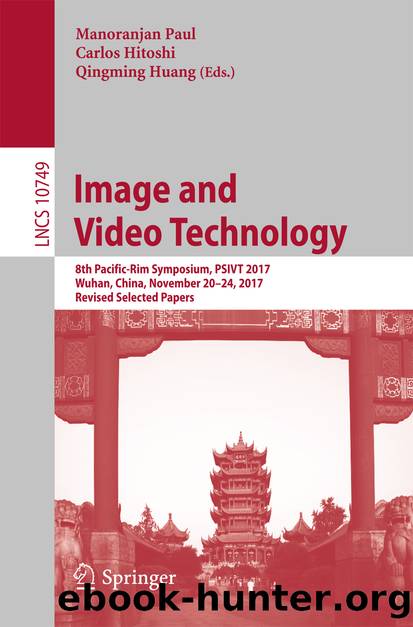Image and Video Technology by Manoranjan Paul Carlos Hitoshi & Qingming Huang

Author:Manoranjan Paul, Carlos Hitoshi & Qingming Huang
Language: eng
Format: epub
Publisher: Springer International Publishing, Cham
2.3 Content and Resolution Invariant Operation on Features
Let us first consider the content (left in Fig. 5) and resolution (right in Fig. 5) based unprocessed L of two example sequences e.g. Poznan_Street and Newspaper presented in Fig. 5. The calculated variations between the highest and lowest values are 41.72% and 28.63% according to the contents and resolutions respectively. Now, the content invariant operation follows a number of steps. First, we figure out the L of the PGPs as mentioned in Sect. 2.2; Second, calculate the average of potential gaze plot (x) and (y) and entitle it by the centre coordinate C(x,y); Third, with respect to C(x,y), we calculate the Euclidean distance of all PGPs and sort the values of length by lowest to the highest order. The rationality of this ordering scheme is due to prioritize the foveal central concentration on pixels by partially avoiding the long surrounded parafoveal, or perifoveal fixations [27] that may incur even with attentive eye browsing; Fourth, to determine the object motion area, we take the average of first sorted values ( in this test since it could help the QMET in obtaining the highest score) which is the foreseen radius of captured affective region; Fifth, the radius is then employed as a divisor of calculated lengths for each potential gaze plots in the First step.
Fig. 5.The video content and resolution based unprocessed Length
Download
This site does not store any files on its server. We only index and link to content provided by other sites. Please contact the content providers to delete copyright contents if any and email us, we'll remove relevant links or contents immediately.
Algorithms of the Intelligent Web by Haralambos Marmanis;Dmitry Babenko(8518)
Test-Driven Development with Java by Alan Mellor(7348)
Data Augmentation with Python by Duc Haba(7249)
Principles of Data Fabric by Sonia Mezzetta(6994)
Learn Blender Simulations the Right Way by Stephen Pearson(6928)
Microservices with Spring Boot 3 and Spring Cloud by Magnus Larsson(6760)
RPA Solution Architect's Handbook by Sachin Sahgal(6166)
Hadoop in Practice by Alex Holmes(6028)
Jquery UI in Action : Master the concepts Of Jquery UI: A Step By Step Approach by ANMOL GOYAL(5869)
The Infinite Retina by Robert Scoble Irena Cronin(5868)
Big Data Analysis with Python by Ivan Marin(5692)
Life 3.0: Being Human in the Age of Artificial Intelligence by Tegmark Max(5397)
Pretrain Vision and Large Language Models in Python by Emily Webber(4652)
Infrastructure as Code for Beginners by Russ McKendrick(4435)
WordPress Plugin Development Cookbook by Yannick Lefebvre(4166)
Functional Programming in JavaScript by Mantyla Dan(4121)
The Age of Surveillance Capitalism by Shoshana Zuboff(4111)
Embracing Microservices Design by Ovais Mehboob Ahmed Khan Nabil Siddiqui and Timothy Oleson(3956)
Applied Machine Learning for Healthcare and Life Sciences Using AWS by Ujjwal Ratan(3929)
